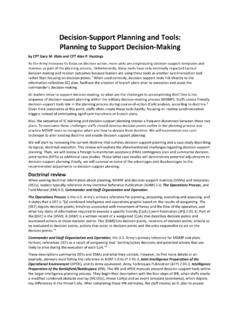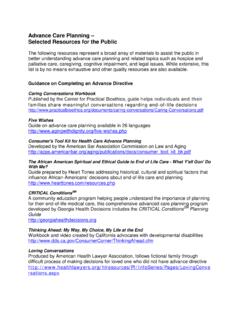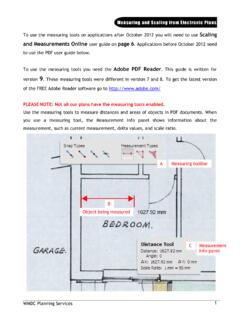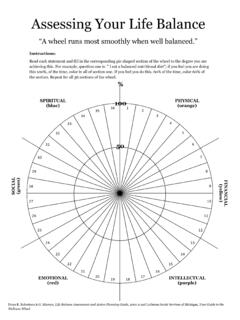Transcription of Camp Planning Tool - Centers for Disease Control and ...
1 Guidance for Operating Youth and Summer Camps: readiness and Planning tool CDC readiness and Planning tool to Prevent the Spread of COVID-19 Among Campers and Staff Overview This tool provides four checklists and a resources list that camp and youth program administrators can use to operate camps while preventing the spread of COVID-19 and protecting campers, their families, staff, and communities. This tool aligns with the CDC's Guidance for Operating Youth and Summer Camps during COVID-19. This tool does not replace federal, state, tribal, local, or territorial health and safety or privacy and confidentiality laws, rules, and regulations with which camps must comply. This tool can be used by camp administrators independently or in consultation with government officials and it may be tailored based on local guidance and camp's needs.
2 Camp administrators, working with local public health officials, should assess the level of community transmission to understand the burden of Disease in the community. The higher the level of community transmission, the more likely that the virus that causes COVID-19 will be introduced into the camp facility from the community, which could lead to in-camp transmission if layered prevention strategies are not in use. Camp administrators should continue to monitor community transmission levels to inform decision on strengthening prevention measures. This tool includes: Checklist #1: General readiness Assessment Captures important information for making initial preparations to promote healthy behaviors, environments, and operations that reduce the spread of COVID-19.
3 Checklist #2: Daily/Weekly readiness Assessment May be used to monitor and maintain recommended practices. Checklist #3: Preparing for If Someone Gets Sick Helps camp and youth program administrators prepare for if someone gets sick and identify special considerations specific to their program and participants, as well as the unique needs and circumstances of the local community. Checklist #4: Special Considerations for Overnight Camps Includes additional information on testing, cohorting, and isolation practices for overnight camps. Additional Resources Provides access to additional information using hyperlinks and URLs. CS 323718-A 5/4/2021. Checklist #1: General readiness Assessment Use this checklist when making initial preparations to promote healthy behaviors, environments, and operations that reduce the spread of COVID-19.
4 Policies and Procedures Facilities and Supplies Education and Training Point Person: Point Person: Point Person: Strongly encourage vaccination for all eligible Obtain supplies including: Educate staff, campers, and their families about individuals. when they should stay home and when they can masks return to camp. Campers should stay home if they: Require consistent and correct use of well-fitting soap have COVID-19 symptoms face masks with proper filtration by all campers, staff, and visitors. hand sanitizer (at least 60% alcohol). have been diagnosed with COVID-19. Develop a plan for campers to stay in cohorts (small paper towels groups) with dedicated staff and remain with the are waiting for COVID-19 test results tissues same group throughout the day, every day.
5 Have been exposed to someone with symptoms cleaning and disinfection supplies or a confirmed or suspected case. Fully Establish camp policies and use strategies to promote physical distancing, indoors and outdoors, of no-touch/foot pedal trash cans vaccinated asymptomatic people can refrain from quarantine, but should continue to monitor at least 3 feet between all campers within a cohort no-touch soap/hand sanitizer dispensers symptoms for 14 days following exposure. at least 6 feet between cohorts gloves (for food service, maintenance, Teach and reinforce consistent and correct use of and other staff) masks. Masks should not be placed on: at least 6 feet while eating and drinking, Other: Children younger than 2 years old including among individuals within the same cohort Develop a schedule for cleaning frequently touched Anyone who has trouble breathing or is surfaces in collaboration with maintenance staff, at least 6 feet between campers and staff unconscious including: at least 6 feet between staff Anyone who is incapacitated or otherwise unable buses or other transport vehicles to remove the mask without help.
6 Plan for activities that can take place outdoors as frequently touched surfaces ( , desks, much as possible. door handles, railings) Provide information on proper use, removal, and washing of masks. Develop a plan for when and where campers will communal spaces ( , restrooms). eat meals. Consider having children and staff eat Make plans for teaching the importance of physical meals and snacks outdoors or in well ventilated water fountains distancing and staying with small groups (cohorts), spaces while maintaining physical distance as shared objects ( , gym equipment, if applicable. much as possible. art supplies, games) Make plans for teaching the importance of Develop a plan for if someone gets sick or shows Other: handwashing with soap and water for at least symptoms of COVID-19.
7 20 seconds. Develop protocols to ensure safe and correct use and storage of cleaners and disinfectants, including Educate staff on flexible work and leave policies that storing products away from children. encourage sick staff to stay at home without fear of job loss or other consequences. 2. Checklist #1: General readiness Assessment (continued from previous page). Policies and Procedures Facilities and Supplies Education and Training Review relevant local/state regulatory agency Ensure heating, ventilation and air conditioning Train staff on all safety protocols. policies and orders, such as those related to events, (HVAC) systems operate properly and maximize gatherings, and travel.
8 Ventilation. Conduct training virtually or while maintaining physical distance (at least 6 feet). Designate a staff person responsible for Develop protocol to increase circulation of outdoor responding to COVID-19 concerns (COVID-19 air as much as possible ( , opening windows and Train all staff on recognizing signs of emotional point of contact). Make sure other staff, parents, doors when it is safe to do so). See the webpage distress and trauma, coping with stress. and campers know how to contact this person. Ventilation in Buildings. Other: Develop policies that encourage sick staff Ensure all water systems and features are safe to to stay at home without fear of job loss or use after a prolonged facility shutdown.
9 Other consequences and protect their privacy, particularly for those with underlying medical Follow CDC's considerations for Pools, Hot Tubs, conditions and at higher risk for severe illness. and Water Playgrounds During COVID-19. Develop a plan to monitor absenteeism of staff, Provide physical guides, such as tape on floors and cross-train staff, and create a roster of trained signs on walls, to promote physical distancing. back-up staff. Space seating at least at least 6 feet apart in Develop policies and practices that allow families between cohorts and between all individuals when flexibility should campers develop symptoms or masks are not used ( , during mealtimes). test positive prior to camp arrival.
10 Ensure adequate supplies to minimize sharing of Develop a plan to conduct daily health checks ( , materials, or limit use to one group (cohort) of temperature screening and/or symptom checking) campers at a time, and clean between use. of staff and campers, as possible, and in accordance Encourage organizations that share the camp with any applicable privacy laws and regulations. facilities to follow these considerations. Develop plan for staff and campers to get Other: screening testing either through a partnership with community providers who offer testing, or referring staff and campers to testing to testing sites in the community. In transport vehicles, create physical distance between campers when possible.
















